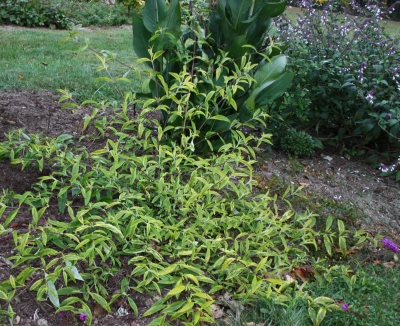…Otherwise known as “splayage”. When vegetatively propagating some species of woody plants, care should be taken when selecting where to take a cutting (piece of stem) to root. Propagation from terminal cuttings (pointy end up) usually results in orthotropism or a vertical growth habit. Cuttings from extremely lateral branches (those that grow parallel to the ground) can, in a few species, result in a spreading growth habit or plagiotropism.
This is not always undesirable – some species are purposefully propagated this way to maintain the prostrate habit that particular cultivar is known for. I’ve propagated lots of Buddleia over the years and don’t recall having this happen. Jeff, you were “Mr. Buddleia”* back in our days at UGA…please weigh in on this!

Buddleia davidii ‘Santana’, author’s garden.
Said plant was purchased from a little Mom & Pop greenhouse as a 4.5” pot with a 6” tall rooted cutting, and it went into our garden in May. It is now lolling all over its neighbors like a drunken sailor. What looks like a vertical piece in the back is simply propped up by the Canna. No big deal, just a good teaching moment.
‘Santana’ is a bit slower-growing than most cultivars of Buddleia, yet is in great demand due to the wacky variegated foliage. My guess? This is the result of repeated acts of propagation via lateral branches…cuttings of cuttings of cuttings. Not to mention the fact that it’s patented, so this guy may not only be floppy, but illegal (!). One of the purported upsides of the plant patenting process is to control the quantity and quality of propagation through licensing. But that’s another post topic for the future.
*Not to be mistaken for the pageant winner “Miss Buddleia”
It's interesting that you posted this today — because I was just lecturing about it to my class yesterday! I haven't noticed that Buddleia was susceptible to plagiotropism, but it doesn't surprise me — it's the sort of plant that I'd expect to respond like this. The "classic" example is yew.
Ya, I haven't noticed it previously, but this particular specimen could be the poster child…
Also: many pardons, I should have referred to you as "Mr. Buddleja." as per your previous post 😉
All we care about out here is how to get rid of it. (Note to Jeff: you'll probably want a different moniker if/when you come out this direction…)
I agree care should be taken when selecting cutting material to avoid splayage. I've spoken to many people who run small, sometimes back yard nurseries, about their propagation practices. A lot of them have said they take cuttings from lateral branches because they strike more reliably – which is true for a lot of taxa. Most of them look at me blankly at the mention of splayage. I can't say there's any Australian taxa that I'm aware of that is prone to plagiotropism.
Yay! I've coined a new term in plant physiology! Jimbo, please continue to spread the word (har!) about "splayage"!!
Jimbo… the Wollomi Pine grows in two different forms depending where the propagating material was taken from; terminal cutings grow vertically and axial bud cuttings grow horizontally. Personally, the idea of a prostrate Wollomi Pine is kinda cool. Incidentally, another example of this is grafted climbing roses. If the bud is taken from a strongly climbing section of the parent plant the grafted rose will also, usually, climb strongly. If it's taken from a smaller, non-vigorous, non-climbing stem then there is a good chance that the climber won't climb. 'Climbing Iceberg' is notorious for it and given it too is propagated in enormous numbers by every man and his dog it's no wonder it appears so often (I also wonder if because it is a climbing sport that it can sometimes revert to its non-climbing version randomly throughout the plant and the non-climbing climbers originated from the reverted material.. hmmm).
While attending the University of Toronto in the Faculty of Forestry and a wood science lecturer had a Croton growing in his office with numerous cuttings in the process of rooting. He gave me a rooted cutting. This was back in 1973. I nurtured this cutting ever since. I have rooted many cuttings which haha kept the plant viable. During the last few years the plant decided to assume plageotrophic tendencies. Not liking this habit I aggressively prunes the crown and rooted two cuttings. Each rooted; one assumes a vertical (orthographic) structure and the other is showing plageotrophic growth. Both cuttings were taken from the upper most portion of the parent plant so I find the plageotrophic growth habit odd. I wonder if this plant can be trained with appropriate restraints to evolve to achieve a vertical structure. I would appreciate any comments. Thanks so much.
It’s worth a try! Once a portion of the trunk has lignified it should keep that orientation, more or less.